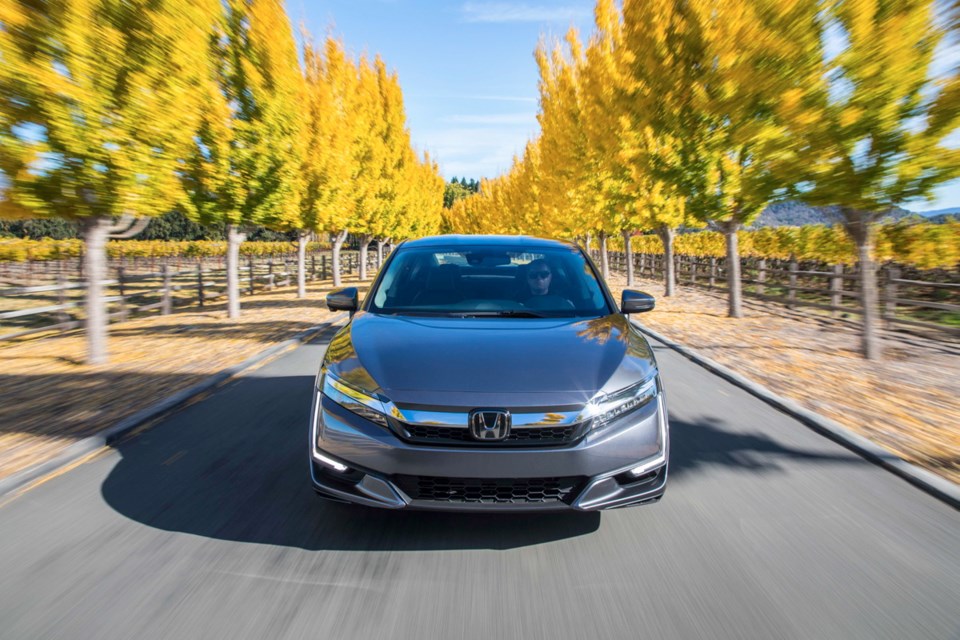Plug-in hybrid vehicles such as the Honda Clarity are likely to play an increasingly significant role in the majority of automobiles we’ll be driving in the near future.
Still, Honda is hedging its bets when it comes to future propulsion systems and has also developed hydrogen-electric and battery-electric versions of the Clarity. For now, they’re only available for lease in California and Oregon.
The midsize sedan is similar to the Honda Accord in length, width and height, but the Clarity is about 7.6 centimetres shorter between the front and rear wheels. The Clarity also weighs about 360 kilograms more than the Accord, mostly due to the heft of the lithium-ion battery pack located beneath the passenger area.
The styling of the Accord and Clarity are somewhat similar, particularly when it comes to their swept-back rooflines, but the Clarity's slightly awkward-looking rear fenders, designed for maximum aero efficiency, have a negative effect on an otherwise passably pleasant shape. Also for aerodynamic and packaging reasons, the Clarity's rump is stubbier than the Accord's, but a glass panel below the trunk lid helps rearward visibility.
The cabin shows no signs of any styling hiccups, however. In fact, the premium materials displayed throughout could easily pass for something from Honda's up-level Acura division. The centrepiece is an eight-inch tablet-style touchscreen that displays the available range in EV modes as well as the energy flow to and from the batteries. A Power Charge Meter dashboard gauge shows the battery-charge level and the energy-consumption status between the gasoline engine and electric drive motor.
As with all plug-in hybrids, the advantage over the non-plug-in hybrids is EV range. Officially, the Clarity can be driven for up to 75 kilometres before the lithium-ion battery pack is depleted to a point where the 1.5-litre gasoline engine fires up to assist. Its primary job is to keep the batteries charged, but under hard acceleration the gasoline engine also fires up to drive the wheels. Doing so will likely be the only time you’ll hear and feel the engine operate, otherwise its existence is barely noticeable.
In combined city and highway operation, the Clarity is rated at 2.1 litres/100 kilometres. Recharge time is a claimed 2.5 hours using a 240-volt outlet.
On its own, the electric motor produces 181 horsepower and 232 pound-feet of torque, while the gasoline assistant puts out 103 horsepower and 98 pound-feet of torque. Combined, there's 212 total system horsepower available. Comparatively, the Toyota Prius Prime plug-in's system makes 121 horsepower, while the Ford Fusion Energi plug-in makes 188.
Instead of a transmission, the Clarity is fitted with a single-speed controller, much like those used in pure battery-electric cars.
Driving the Clarity is a smooth and quiet experience. Power is decent for such a hefty sedan, steering is precise and the car's low centre of gravity seems to help it hug the road.
Drivers can select from Normal, Sport and Econ modes. A separate HV button can be activated for all three. It's used to recharge the batteries to 58 per cent of capacity before automatically switching off. Steering-wheel-mounted deceleration selectors act like hand-operated brake pedals to add or reduce the regenerative braking energy fed into the batteries. The Clarity plug-in hybrid is estimated to have a 547-kilometre range.
Pricing starts at $39,900, including destination charges, with the usual assortment of comfort items plus automated safety technologies such as emergency braking and lane-keeping assist.
The Touring package adds leather-trimmed seats (heated and power-adjustable in front), faux suede dashboard trim and a navigation system.
With Honda's intention to electrify two-thirds of its lineup by 2030, there’s a lot riding on the Clarity's shoulders. It won't win over crowds on its looks alone, but its smooth and quiet drive might just be enough.
THE SPEC SHEET
Type: Four-door, front-wheel-drive midsize sedan
Engine (h.p.): 1.5-litre DOHC I-4 with electric motor (212, net)
Transmission: Single-speed controller
Market position: Honda’s plan to electrify two-thirds of its fleet by 2030 is now underway with the launch of the Clarity Plug-In. Electric- and hydrogen-powered versions are available in limited quantities.
Points: Similar in size to the Accord, but not nearly as good looking.
• High-tech Interior appointments are also stylish.
• Electric-only range will be enough for most daily commutes.
• Hybrid combo provides decent performance for a 4,000-plus-pounds vehicle.
• Encouraging to see all the latest active safety tech included in the base trim level.
Active safety: Blind-spot warning with cross-traffic backup alert (std.); active cruise control (std.); emergency braking (std); lane-keeping alert/assist (std.)
L/100 kilometres: 2.1
Base price (incl. destination): $39,900



